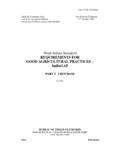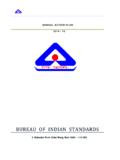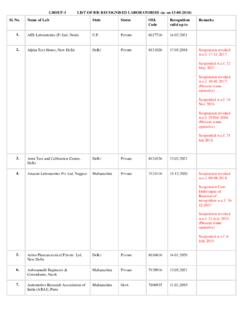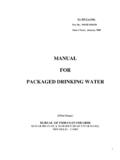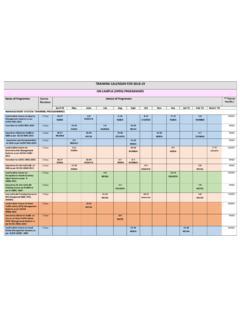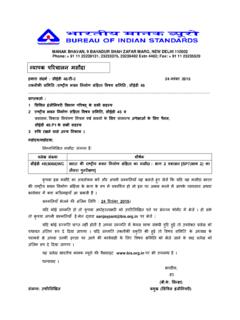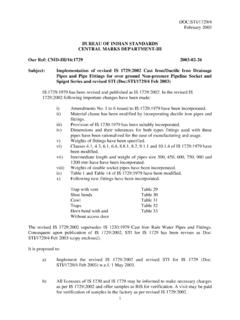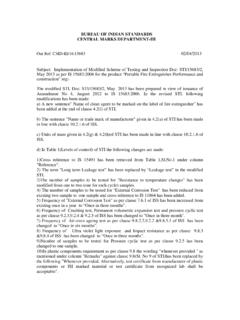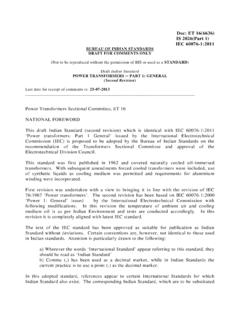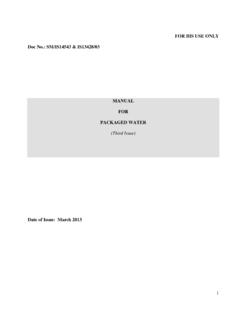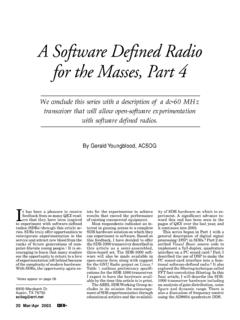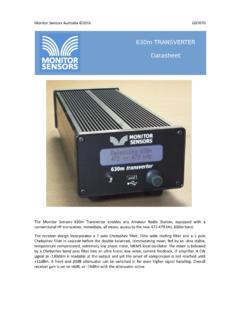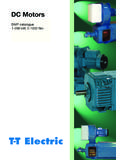Transcription of Doc: ET 31(6128) BUREAU OF INDIAN STANDARDS DRAFT …
1 1 Doc: ET 31(6128) BUREAU OF INDIAN STANDARDS DRAFT FOR COMMENTS ONLY (Not to be reproduced without the permission of BIS or used as a STANDARD) DRAFT INDIAN Standard UNINTERRUPTIBLE POWER SYSTEMS (UPS) Part 3 Method of Specifying the Performance and Test Requirements Last date for receipt of comments is 15-11-2008. NATIONAL FOREWORD (will be added later) 1 Scope and object This standard applies to electronic indirect converter systems with electrical energy storage means in the link. The primary function of the uninterruptible power system (UPS) covered by this standard is to ensure continuity of an alternating power source. The uninterruptible power system may also serve to improve the quality of the power source by keeping it within specified characteristics. A variety of uninterruptible power systems have been developed to meet consumers' requirements for continuity and quality of power for different types of loads over a wide range of power, from less than 100 W to several megawatts.
2 Refer to annexes A and B for information on some of the types available. This standard applies to electronic uninterruptible power systems (UPS): a) delivering single- or three-phase fixed frequency output voltage; b) with energy storage device in the link if not otherwise specified; c) with rated voltage not exceeding 1 000 V ; d) movable, stationary and/or fixed equipment. This standard also includes the method of specifying all power switches that form integral parts of a UPS and are associated with its output. Included are interrupters, bypass switches, isolating switches, load transfer switches and tie switches. These switches interact with other functional units of the UPS to maintain continuity of load power. This standard does not refer to conventional mains distribution boards, rectifier input switches or switches (for example for batteries, rectifier output or inverter input, etc.
3 , or UPS based on rotating machines. 2 NOTE 1 This standard recognizes that the major market usage with the UPS ratings within its scope is in conjunction with information technology equipment. Under current technology, the majority of UPS load equipment employs power supplies which present a non-linear load to the UPS and can be tolerant of non-sinusoidal voltage waveforms for a limited time duration. UPS output ratings are specified to be compatible with non-linear loading and linear loading, subject to manufacturers' declaration if different. References within this standard to linear loading are retained for test method reasons, or validation of manufacturers' additional declaration. NOTE 2 For use of UPS with a non-sinusoidal output voltage waveform, beyond the stored-energy time recommended in this standard, the agreement of the load equipment manufacturer should be sought.
4 NOTE 3 For UPS output frequencies other than 50 Hz or 60 Hz, performance specification is subject to agreement between manufacturer and purchaser. This standard is intended to define a complete uninterruptible power system in terms of its performance and not individual UPS functional units. The individual UPS functional units are dealt with in the IEC publications referred to in the bibliography given in annex I, which apply in so far as they are not in contradiction with this standard. 2 Normative references The following normative documents contain provisions which, through reference in this text, constitute provisions of this part of IEC 62040. For dated references, subsequent amendments to, or revision of, any of these publications do not apply. However, parties to agreements based on this part of IEC 62040 are encouraged to investigate the possibility of applying the most recent editions of the normative documents indicated below.
5 For undated references, the latest edition of the normative document referred to applies. Members of IEC and ISO maintain registers of currently valid International STANDARDS . IEC 60050-101:1998, International Electrotechnical Vocabulary (IEV) Part 101: Mathematics IEC 60050(131):1978, International Electrotechnical Vocabulary (IEV) Chapter 131: Electric and magnetic circuits IEC 60050(151):1978, International Electrotechnical Vocabulary (IEV) Chapter 151: Electrical and magnetic devices IEC 60050(161):1990, International Electrotechnical Vocabulary (IEV) Chapter 161: Electromagnetic compatibility Amendment 1 (1997) IEC 60050(351):1975, International Electrotechnical Vocabulary (IEV) Chapter 351: Automatic control 3 IEC 60050(441):1984, International Electrotechnical Vocabulary (IEV) Chapter 441: Switchgear, controlgear and fuses IEC 60050(486):1991, International Electrotechnical Vocabulary (IEV) Chapter 486.
6 Secondary cells and batteries IEC 60050(551):1998, International Electrotechnical Vocabulary (IEV) Chapter 551: Power electronics IEC 60050(826):1982, International Electrotechnical Vocabulary (IEV) Chapter 826: Electrical installations of buildings IEC 60068-2-1:1990, Environmental testing Part 2: Tests. Tests A: Cold IEC 60068-2-2:1974, Environmental testing Part 2: Tests. Tests B: Dry heat IEC 60068-2-27:1987, Environmental testing Part 2: Tests. Test Ea and guidance: Shock IEC 60068-2-32:1975, Environmental testing Part 2: Tests. Test Ed: Free fall (Procedure 1) IEC 60068-2-48:1982, Environmental testing Part 2: Tests. Guidance on the application of the tests of IEC 60068 to simulate the effects of storage IEC 60068-2-56:1988, Environmental testing Part 2: Tests.
7 Test Cb: Damp heat, steady-state, primarily for equipment IEC 60146-1-1:1991, Semiconductor converters General requirements and line commutated converters Part 1-1: Specifications of basic requirements Amendment 1 (1996) IEC 60146-1-2:1991, Semiconductor converters General requirements and line commutated converters Part 1-2: Application guide IEC 60146-2:1974, Semiconductor converters Part 2: Semiconductor self-commutated convertors IEC 60309 (all parts), Plugs, socket-outlets and couplers for industrial purposes IEC 60364-4 (all parts), Electrical installations of buildings Part 4: Protection for safety IEC 60417-1:1998, Graphical symbols for use on equipment Part 1: Overview and application IEC 60529:1989, Degrees of protection provided by enclosures (IP Code) IEC 60950:1991, Safety of information technology equipment 4 IEC 60990:1990, Methods of measurement of touch-current and protective conductor current 1) IEC 61000-2-2:1990, Electromagnetic compatibility (EMC) Part 2: Environment Section 2: Compatibility levels for low-frequency conducted disturbances and signalling in public low-voltage power supply systems IEC 61140:1997, Protection against electric shock Common aspects for installation and equipment IEC 602040-2: , Semiconductor converters Uninterruptible power systems (UPS) Part 2: Electromagnetic compatibility (EMC) requirements ISO 7000:1989, Graphical symbols for use on equipment Index and synopsis ISO/DIS 7779.
8 , Acoustics Measurement of airborne noise emitted by computer and business equipment 2) 3 Terms and definitions For the purpose of this standard, the following definitions apply. In this standard, IEV definitions are used wherever possible, particularly those in IEC 60050(551). Systems and components uninterruptible power system (UPS) combination of converters, switches and energy storage means, for example batteries, constituting a power system for maintaining continuity of load power (see ) in case of input power failure converter operative unit for electronic power conversion, comprising one or more electronic valve devices, transformers and filters if necessary and auxiliaries if any [IEV 551-12-01] UPS functional unit functional unit, for example, a UPS rectifier, a UPS inverter or a UPS switch UPS rectifier an converter for rectification [IEV 551-12-07 modified] 1) A second edition is at present under consideration.
9 2) To be published. (Revision of ISO 7779:1988). UPS inverter an converter for inversion [IEV 551-12-10 modified] DC energy storage system system consisting of single or multiple devices (typically batteries) designed to provide the required stored energy time DC link direct current power interconnection between the rectifier or rectifier/charger and the inverter functional unit (secondary) battery two or more secondary cells connected together and used as a source of electric energy [IEV 486-01-03] valve regulated sealed (secondary) cell secondary cell which is closed under normal conditions, but has an arrangement to allow gas to escape if the internal pressure exceeds a predetermined value. The battery cannot normally receive addition to the electrolyte [IEV 486-01-20] vented (secondary) cell secondary cell having a cover provided with an opening through which gaseous products may escape [IEV 486-01-18] NOTE The opening may be fitted with a venting system.
10 Battery charger device for changing alternating current power to direct current power for the purpose of charging a battery UPS switch switch (quenched, line or self commutated, electronic or mechanical, depending on required continuity of load power) used to connect/isolate UPS or bypass to/from load transfer switch UPS switch consisting of one or more switches used to transfer power from one source to another electronic (power) switch operative unit for electronic power switching comprising at least one controllable valve device [IEV 551-13-01] mechanical UPS (power) switch mechanical switching device capable of making, carrying and breaking currents under normal circuit conditions which may include specified operating overload conditions and also carrying for a specified time currents under specified abnormal circuit conditions such as those of short circuit [IEV 441-14-10 modified] NOTE A switch may be capable of making but not breaking short-circuit currents.
